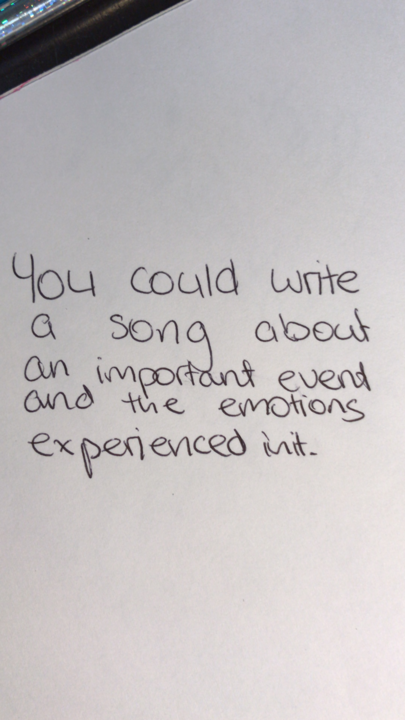Share ideas for a song
Write and perform a short original song about nature using simple melody, rhymes, and homemade percussion instruments to explore rhythm and storytelling.



Step-by-step guide to write and perform a short original song about nature
A music lesson | Instruments and musical figures for kids
Step 1
Pick one nature topic you love like rain trees birds wind or a stream.
Step 2
Write 8 to 10 words and short sounds that remind you of that topic such as drip whoosh chirp rustle.
Step 3
Decide your song shape by choosing a chorus and two short verses.
Step 4
Write a chorus of 2 to 4 lines that repeat and try to make the last words rhyme.
Step 5
Write two verses of 2 to 3 lines each using words from your brainstorm.
Step 6
Hum different tunes for the chorus out loud and pick the simplest melody that feels easy to sing.
Step 7
Make two shakers by putting a small handful of rice or beans into each container and sealing the lids with tape or a rubber band.
Step 8
Test different drum sounds by tapping a wooden spoon on a pot or box to find one sound you like.
Step 9
Choose one simple rhythm pattern for the chorus and one for the verses and clap it slowly three times.
Step 10
Practice singing the chorus and verses while playing your shakers and drum following your chosen rhythms.
Step 11
Add one or two gestures or movements to help tell the story while you sing.
Step 12
Perform your finished song for family or friends and ask them what they liked.
Step 13
Share your finished song on DIY.org
Final steps
You're almost there! Complete all the steps, bring your creation to life, post it, and conquer the challenge!


Help!?
What can we use instead of rice or beans if we can't find them?
Use dried pasta, lentils, beads, or small pebbles inside the containers and then seal the lids with tape or a rubber band as described in the shaker-making step.
My melody keeps sounding messy—how do we fix it?
If your hummed melodies clash, simplify by choosing the simplest melody you find when you hum the chorus out loud, slow it down, and practice singing the chorus while clapping the chorus rhythm three times.
How can I adapt this activity for younger or older kids?
For younger children, limit to one nature word, one sealed shaker from the shaker step, and humming a very short chorus, while older kids can write full 8–10 brainstorm words, create two distinct rhythm patterns, and add more complex gestures and a recorded performance for DIY.org.
How can we make the finished song more special or performative?
Enhance the song by adding tuned glasses or different-sized pots discovered during the drum-testing step, arranging call-and-response between chorus and verses, designing gestures from the movement step, and filming the performance to share on DIY.org.
Watch videos on how to write and perform a short original song about nature
Learn Instruments with Mia! ⭐ LittleBabyBum Nursery Rhymes - One Hour of Baby Songs
Facts about songwriting and music for kids
✍️ Rhymes and repetition in songs boost memory and language skills, which is why catchy choruses help kids remember stories and facts.
🎵 Many children's songs use the pentatonic (five-note) scale, which makes melodies easy to sing and improvise without clashing notes.
🐦 Nature itself has musical patterns — birdsongs and frog calls often use repeating rhythms and pitches that inspire melodies about the outdoors.
🎶 The Hurrian Hymn to Nikkal (around 1400 BCE) is the oldest known song written down — it's over 3,400 years old!
🥁 You can make real percussion from household items: pots and pans as drums, sealed bottles with rice as shakers, and tin cans stretched with a balloon as hand drums.
How do I help my child write and perform a short original song about nature?
What materials do I need to write and perform a nature song with homemade percussion?
What ages is this nature songwriting and performance activity suitable for?
What are the benefits of writing and performing a nature song with homemade instruments?


One subscription, many ways to play and learn.
Only $6.99 after trial. No credit card required



